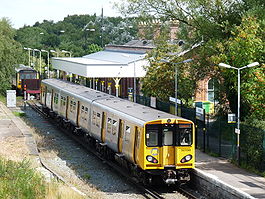- Ormskirk railway station
-
Ormskirk 
View from the roadbridge; note how the electric Merseyrail train and diesel Northern Rail train are separated by a buffer. Location Place Ormskirk Local authority West Lancashire Coordinates 53°34′09″N 2°52′52″W / 53.5692°N 2.8811°WCoordinates: 53°34′09″N 2°52′52″W / 53.5692°N 2.8811°W Operations Station code OMS Managed by Merseyrail Number of platforms 2 Live arrivals/departures and station information
from National Rail EnquiriesAnnual rail passenger usage 2004/05 * 0.693 million 2005/06 *  0.716 million
0.716 million2006/07 *  0.733 million
0.733 million2007/08 *  0.770 million
0.770 million2008/09 *  1.028 million
1.028 million2009/10 *  0.999 million
0.999 millionPassenger Transport Executive PTE Merseytravel Zone F National Rail - UK railway stations A B C D E F G H I J K L M N O P Q R S T U V W X Y Z * Annual passenger usage based on sales of tickets in stated financial year(s) which end or originate at Ormskirk from Office of Rail Regulation statistics. Please note: methodology may vary year on year. Ormskirk railway station is situated in the town of Ormskirk, Lancashire, England. The station is an interchange between Merseyrail services from Liverpool Central and Northern Rail services from Preston. The station building and three arch road bridge are both Grade II listed structures.
The station was built by the East Lancashire Railway, Liverpool, Ormskirk and Preston section, and opened on 2 April 1849. From 13 May 1859, the station was owned by the Lancashire and Yorkshire Railway. From 1 January 1923 the station was owned by the London, Midland and Scottish Railway. British Railways nationalised all railways on 1 January 1948 and the station became part of the London Midland Region.
The current station consists of a single platform. An interesting characteristic is how the electric Merseyrail trains and diesel Northern Rail trains are separated on arrival by a large buffer, so passengers wishing to go from one to another walk a dozen yards or so along the platform to move between trains. (A similar layout exists at Kirkby.) Prior to the restructuring of the railways in the 1960s and 1970s, there were two platforms. The EMU commuter trains would pull into a bay platform (with buffers) as can be seen on the 1915 photograph (to the right of the picture). This practice ended following the withdrawal of through trains between Liverpool and Preston via this route (the last through trains ran on 3 May 1970) and all trains now use the former Liverpool platform (the Preston-bound Up platform remains but is disused). The bay platform is now a footpath leading to the bus station.
Services to Liverpool Central operate frequently, running every 15 minutes during the day and every 30 minutes at other times. Services to Preston are irregular, with a total of 12 services in each direction Monday–Saturday, and no service on Sundays.
The former link between Ormskirk and Southport, via the Burscough Curves, was closed in 1962. The Skelmersdale Branch has also been lost, having closed to passengers in 1956 and to all traffic seven years later. It was lifted in 1968, though the Burscough curves remained extant until the mid 1980s.[1]
Refurbishment
The Ormskirk Advertiser announced in June 2008 that Ormskirk railway station was to undergo a £1.5 million makeover, a project which was run in partnership between West Lancashire District Council, Lancashire County Council, Merseyrail and Network Rail. Among the refurbishments include a new booking hall, waiting room, toilet facilities, ticket counters and new automatic swinging doors, as well as a remodelled and landscaped path and bicycle route up to the bus interchange. Work started in January 2009[2] and completed during the summer of 2009, with the opening taking place on 31 July 2009. The station is classed as eco-friendly and gets its green credentials by using a system that harvests rainwater, as well as other various energy-saving measures.[3]
References
- ^ Marshall, J. (1981) Forgotten Railways North-West England, David & Charles (Publishers) Ltd, Newton Abbott. ISBN 0 7153 8003 6, p.93
- ^ Work to begin on £1.5m makeover at Ormskirk train station
- ^ New-look ‘eco-friendly’ Ormskirk station opens
External links
- Train times and station information for Ormskirk railway station from National Rail
- Station information from Merseyrail
Preceding station  National Rail
National RailFollowing station Aughton Park Merseyrail
Northern LineTerminus Burscough Junction Northern Rail
Ormskirk Branch Line
Mondays-Saturdays onlyTerminus Disused railways Terminus Lancashire and Yorkshire Railway
Skelmersdale BranchWesthead Halt Merseyrail Northern Line Stations Southport - Hunts Cross Branch Hunts Cross • Liverpool South Parkway • Cressington • Aigburth • St Michaels • Brunswick • Liverpool Central • Moorfields • Sandhills • Bank Hall • Bootle Oriel Road • Bootle New Strand • Seaforth & Litherland • Waterloo • Blundellsands & Crosby • Hall Road • Hightown • Formby • Freshfield • Ainsdale • Hillside • Birkdale • SouthportOrmskirk Branch Liverpool Central • Moorfields • Sandhills • Kirkdale • Walton • Orrell Park • Aintree • Old Roan • Maghull • Town Green • Aughton Park • OrmskirkKirkby Branch Liverpool Central • Moorfields • Sandhills • Kirkdale • Rice Lane • Fazakerley • Kirkby • (Headbolt Lane - Proposed)Railway stations in Lancashire West Coast Main Line Kirkby Branch Line Manchester to Southport Line Merseyrail Northern Line Town Green • Aughton Park • OrmskirkOrmskirk Branch Line Blackpool Branch Lines Manchester to Preston Line Ribble Valley Line East Lancashire Line Preston • Lostock Hall • Bamber Bridge • Pleasington • Cherry Tree • Mill Hill • Blackburn • Rishton • Church and Oswaldtwistle • Accrington • Huncoat • Hapton • Rose Grove • Burnley Barracks • Burnley Central • Brierfield • Nelson • ColneCaldervale Line Leeds to Morecambe Line Furness Line Heritage Railways Irwell Vale • Rawtenstall • Riversway • Strand Road CrossingCategories:- Ormskirk
- Railway stations in West Lancashire
- Former Lancashire and Yorkshire Railway stations
- Railway stations served by Merseyrail
- Railway stations served by Northern Rail
- DfT Category D stations
Wikimedia Foundation. 2010.



